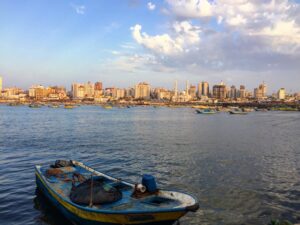
Read more
Blog, Migration Governance
What does genocide do to migration categories?
The mass displacement of Palestinians in Gaza over the past year raises urgent questions for migration policymakers and researchers about how we understand and categorise migration. Traditional migration and displacement definitions, shaped by historical...
One month ago, Satnam Singh died in a hospital south of Rome. A fruit wrapping machine had severed the Indian farm worker’s arms and fractured his legs. Instead of calling emergency services, his employer drove him home and left him at his front door, his dismembered arm in a vegetable collection box beside him. In a later investigation, it emerged that Singh had neither a work contract nor a residence permit and had been working at the same Italian agriculture company for two years.
The exploitation of foreign agricultural workers in Italy has long been viewed as a problem in the South of the country. But Singh was working in Lazio.
In this blog, we’ll highlight the growing evidence about the exploitation of foreign agriculture workers across the country, including in both central and northern Italy and highlight how those who harvest food proudly branded as Made in Italy continue to live, work and in cases like Singh, die in a state of privation.
Italy’s agricultural workers
The Made in Italy brand for food and wine is a source of pride in Italian entrepreneurship. It has become so important that the former Ministry of Industry and Trade has been renamed as the Ministry for Business and Made in Italy under Meloni’s government.
As of 2022, Italy had just over 1 million agricultural workers. Of these, 10 per cent were intra-EU migrants and 36 per cent were third-country nationals (TCNs). Existing reports and research suggest that at least 230k of all agricultural workers – Italians, TCNs, and EU alike – were illegally employed, i.e., roughly a quarter of the total of agricultural workers employed in the Italian countryside.
Quota-visa system
Across Italy, employers in agriculture are increasingly facing difficulties finding workers, especially after the COVID-19 pandemic. As a solution to this systemic lack of workforce, quotas for seasonal workers (mainly agriculture and tourism) have significantly increased as opportunities for protection have diminished. When Meloni took office, she increased the quota for seasonal workers from what was 18K in 2019 to 89K in 2024. This created more opportunities for TCNs to receive a visa to come to Italy for seasonal work, the rationale being that it provided jobs for migrant workers who needed them while serving Italy in the process. These policies fall under the rhetoric of the current government that Italy is a country for workers, not for asylum seekers.
The reality of this Italian quota-visa system is rife with issues. One critical issue is that the system only allows employers to ask for a work visa for TCN workers who are abroad and not those who already reside in Italy. Another is that the visa is only for the allocated period of seasonal work and those who arrive on this type of quota visa from very distant countries cannot afford to return home between seasons and so end up staying and working for the same employer (or others, through networks) throughout the year. Also, while the Italian quota system allows seasonal workers to convert their visas into another type for subordinate work – either fixed-term or permanent – it must remain within the limits of the quotas, and only 4000 conversions are possible every year.
The TCN agricultural workers who were in Italy before the increased quota system were largely asylum seekers or individuals who applied for the last (Covid-induced) regularization campaign in 2020 (which specifically targeted agriculture, care and domestic workers). Among them, there are TCNs who have been in Italy for a decade or more and find themselves struggling every day to keep (or re-gain) their Italian residence permit while working in agriculture.
Tuscany: not exempt
Tuscany is home to many businesses and cooperatives that profit from the Made in Italy brand. It’s also home to the institution publishing this blog. The Tuscan viticulture sector is known worldwide for its excellence. Yet in Tuscany, recent research highlights the exploitation and precarity of foreign workers producing these products similar to that which has long been documented in the rest of the country. These include:
- not having a regular contract
- having wages deducted at source or under the minimum threshold,
- being forced to work long hours and weeks without breaks, and
- being subjected to poor workplace health and safety.
In Tuscany alone, over 40 per cent of the 58K agricultural workers are foreigners, and 90 per cent work with fixed-term contracts, justified by the seasonality of the agricultural work. However, this is often compounded by the fact that employers recruit foreign workers with contracts that might technically be legal in some sense but are applied incorrectly to the type of work and worker (e.g., traineeship contracts).In many cases, migrants reported having received pressure and threats related to the performance of their work aimed at increasing their speed and subsequent profits for the employer. Although the law no. 199/2016 explicitly punishes labour exploitation in agriculture – by amending the criminal code (art. 603bis), – targeting both abusive gang masters (so called caporali[1]) and employers who take advantage of workers, often its enforcement is difficult and even controversial.
In Tuscany as elsewhere, the precarity of many TCN’s legal status creates the perfect storm of work exploitation and undignified living and housing. While a significant amount of funding has been (and is still being) deployed to address this decades-long situation, the conditions for foreign agricultural workers continue to be dire.
So where do we go from here?
With the wealth of information we have about how workers’ rights are violated in the agricultural sector in Italy, greater attention is needed on the interests at play and on the systems – including visa structures – that enable this exploitation to continue.
Our ongoing research through the Protecting Irregular Migrants in Europe (PRIME) project is trying to better understand the systems perpetuating this exploitation by collecting the views of employers, regular and irregular foreign workers, policy actors, employer associations and trade unions. As part of this, two of us have been working in locations across the country (Lazio, Puglia, Emilia-Romagna) conducting interviews. These have included talking to workers in the province of Foggia with workers living in Borgo Mezzanone. A young agricultural worker who arrived in Italy as an unaccompanied minor told us that even though he currently has a residence permit, he fears not being able to prove that he has been working in the agricultural sector in order to renew its residence permit in the future: “If the questura [the police office where residence permits are processed] asks for proof of a work contract and residence, and you cannot prove where you live and work, what can you do? That is the problem.”[2]
Another agricultural worker without a residence permit, told us: “Without documents everything is problem: work, housing, everything”. It’s time we understand what are the factors and actors that could play a role in breaking the vicious circle of exploitation in agriculture which taint the Made in Italy brand.
[1] Expression used to refer to illegal labour intermediation, workers’ irregular recruitment and organization, and labor exploitation (mainly) in the agricultural sector that disproportionally affect migrant workers and often lead to forced and bonded labor situations
[2] “Se questura chiede e tu non hai la possibilità di dimostrare dove sei o dove lavori, cosa devi fare? Il problema è quello.”
—–
Leila Giannetto is a Research Fellow at the Migration Policy Centre of the European University Institute. You can follow her on X, visit her on LinkedIn or contact her at Leila.Giannetto@eui.eu
Caterina F. Guidi is a former Research Fellow at the Robert Schuman Centre for Advanced Studies of the European University Institute. You can follow her on X, visit her on LinkedIn or contact her at Caterina.Guidi@eui.eu
Caitlin Procter is a part-time Professor at the Migration Policy Centre of the European University Institute. You can follow her on X, visit her on LinkedIn or contact her at Caitlin.Procter@eui.eu

